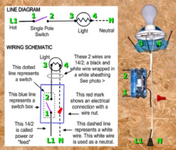kthree
Mechanical
- Aug 9, 2004
- 59
Just experienced an issue with a light switch on the wall in my house that I absolutely do not understand and would enjoy any comments any wish to offer. First off, electricity is not my thing. Lights, switches, and plugs I can handle but anything else is outside my expertise and definitely outside my comfort zone. With that in mind, buckle in, here we go. This house probably dates to the 50's, has hosted many different occupants, and I have now lived in it for just over 20 years. About a week ago, I flipped the wall switch and the ceiling light came on as always, but in a few seconds it began flickering. I flipped the switch off, waited a few seconds, and flipped the switch back on. Everything was good. Well, I'm sure you know where this is going... every time it took more switch flips to get the light to stay on without flickering. When it got to the point that it required me to push the toggle sideways to stop the flickering, it was definitely time to get serious about addressing the issue. When I went to remove the wall plate, I found an inlet cut into the molding to make room for the wall plate. The inlet wasn't exactly in the right place and the wall plate was forcing the switch sideways. Once I got the wall plate off, and without messing with the switch mounting in any way, the switch worked properly. But when I put the wall plate back into place, with the plate binding against the switch as before, the switch resumed not working properly. I tried backing the wall plate mounting screws out a bit in hopes of relieving some of the binding but even though I tried to convince myself the issue was better, it really wasn't. It was definitely time to replace the switch. After killing the circuit at the breaker box, I removed the wall plate again. Then, before replacing the switch, I simply pulled it out of the box enough to check to make sure the terminal screws were tight. It is a standard 2 pole switch, powering one light fixture, and both wires are black. The first terminal screw seemed quite tight enough. The other terminal screw wasn't loose but it turned a bit, probably less than a 1/16 of a turn. At that point, curiosity got the better of me, so I remounted the switch, sawed off about 1/4" of the bottom of the wall plate so it no longer touched the molding, and remounted it. Nothing appeared to be in a bind now. I reheated the circuit and came back and tested the switch. It worked great EXCEPT, now down is on and up is off! Why? I changed nothing. Has anyone else experienced something like this? Is this something to be concerned about? All suggestions, ideas, comments any wish to offer will be greatly appreciated. Thanks, K.

